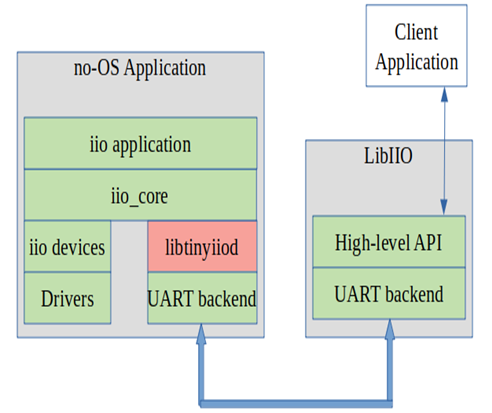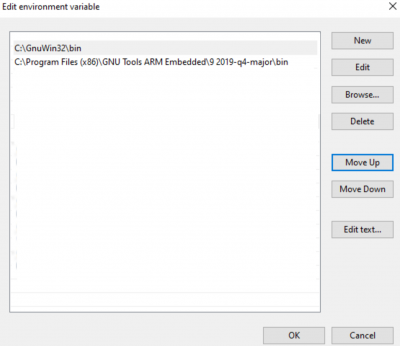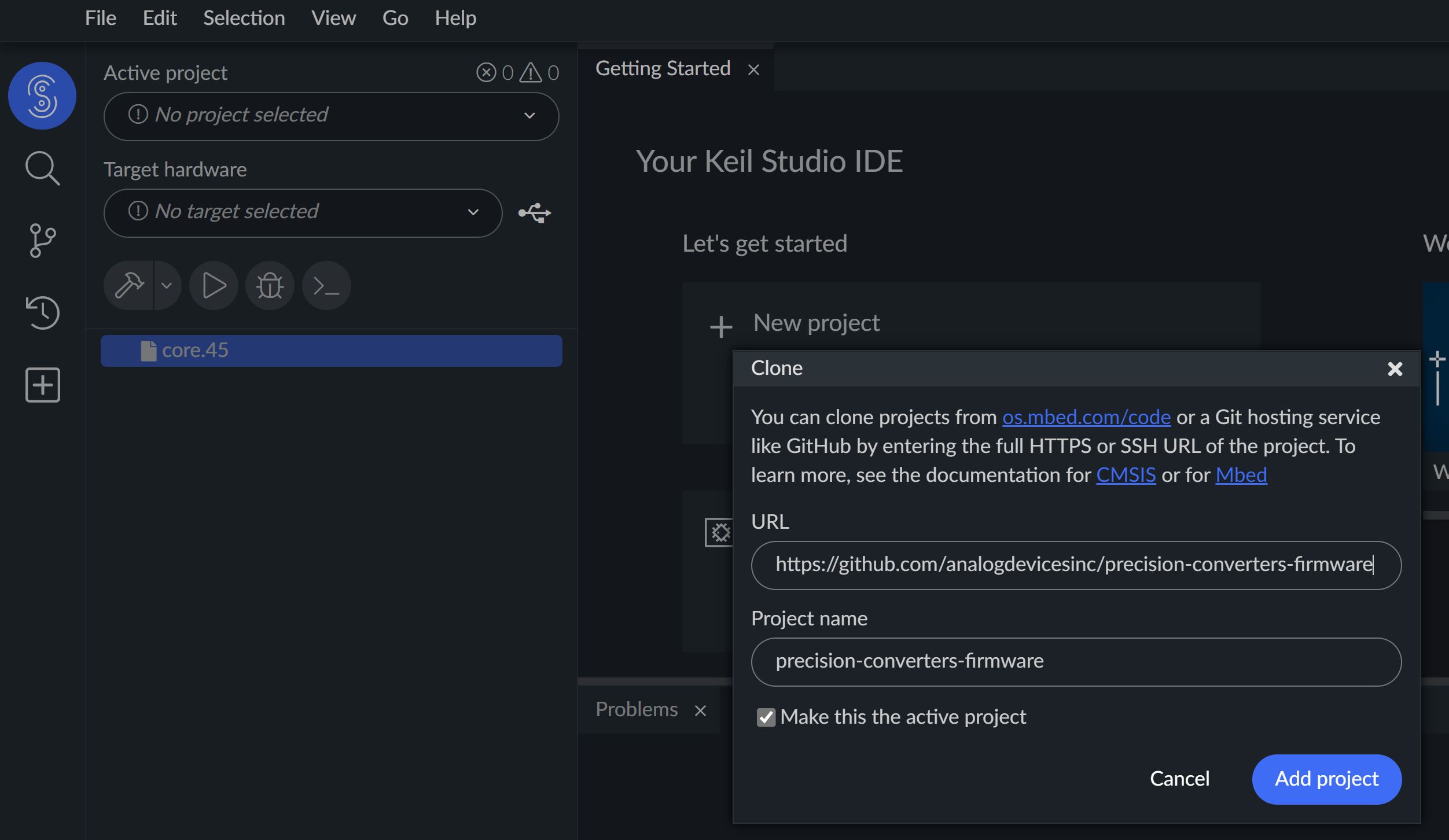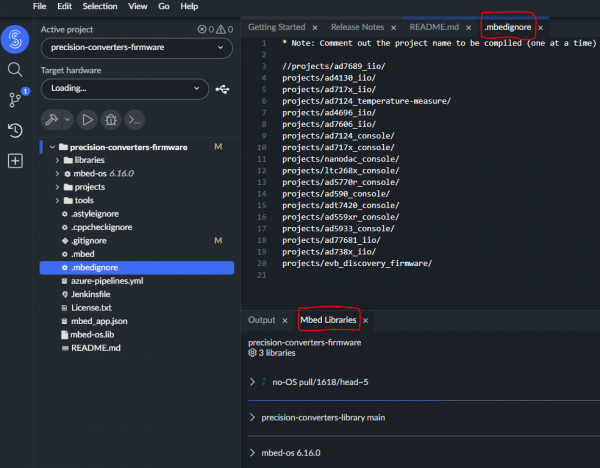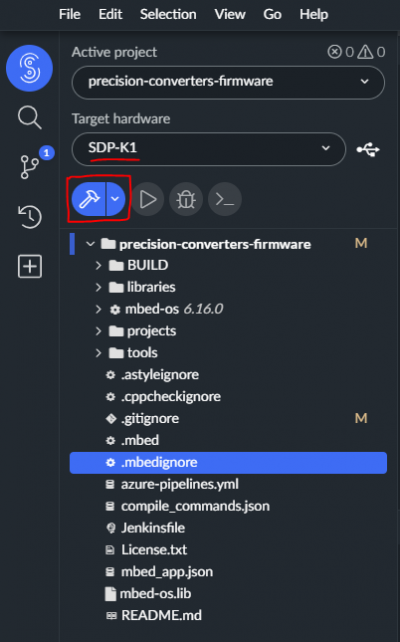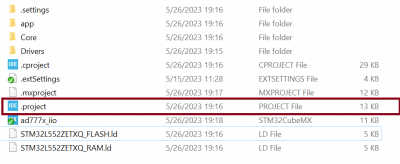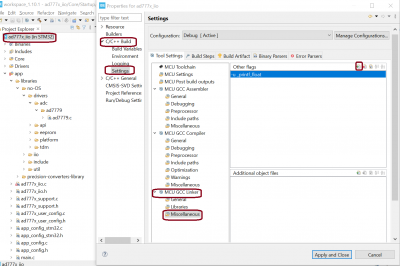AD738x IIO Application
Supported Hardware
Supported Devices:
Supported Evaluation Boards:
Supported Carrier Boards:
Introduction
This guide gives an overview of using the IIO firmware application with Analog Devices AD738x Evaluation board and SDP-K1 (or other compatible) MCU controller board, leveraging Mbed-OS as a primary software platform. This firmware application leverages the ADI developed IIO (Industrial Input Output) ecosystem to evaluate the AD738x (IIO) device by providing device configuration and data capture support.
The interface used for communicating with PC based IIO clients is either Virtual Serial Or UART. IIO Firmware leverages the ADI created no-os and platform driver software layers to communicates with IIO device.
Note
This code has been developed and tested on the SDP-K1 Controller Board with Arduino headers. However, the same code can be used with minimal modifications on any Mbed enabled board which has Arduino Header support on it. To find out all supported Mbed boards, refer this link: https://os.mbed.com/platforms/
Useful Links
Note
Linux and HDL are not used in emebdded IIO firmware projects but they may be of interest if you require Linux and/or FPGA support.
Hardware Connections
Required: SDP-K1 (or alternative Mbed enabled controller board), EVAL-AD738x board, 9V adapter and USB cable.
Connect the EVAL-AD7380 board to SDP-K1 board (or any other Mbed enabled controller board) using jumper wires. Connect SDP-K1 board to the PC using the USB cable. AD738x FMC EVB is powered through external 9-12V DC adapter.
Jumper Settings
SDP-K1:
Connect the VIO_ADJUST jumper on the SDP-K1 board to 3.3V position to drive SDP-K1 GPIOs at 3.3V
EVAL-AD738xFMCZ:
Use default board settings.
Communication Interface
Note
For data transmission to IIO clients, IIO firmware applications uses Virtual Serial Or UART as primary communication links. Firmware by default uses the Virtual Serial interface for SDP-K1 for higher speed data transmission as SDP-K1 board supports both Virtual Serial and UART interface. The Nucleo-H563 supports only UART. If you target a different MCU board that does not support Virtual Serial, just set UART as communication link in the firmware (app_config.h file).
MCU board is powered through USB connection from the computer. It acts as a serial device when connected to PC, which creates a serial ports to connect to IIO client application running on PC. The serial port assigned to a device can be seen through the device manager for windows-based OS as shown below:

Note
The serial port naming is used differently on different operating systems. For example, Linux uses terms such as dev/ttyUSB* and Mac uses terms such as dev/tty.USB*. Please check serial port naming for your selected OS.
Identifying Virtual Serial Port (Windows-OS):
To identify if serial port is virtual, right click on the port name and select ‘Properties’. Select ‘Events’ from menu option and check for below highlighted VIDs/PIDs and firmware name which is currently running on MCU.

SDP-K1 can support high speed Virtual Serial USB interface, so by default Virtual Serial is configured as default interface. The interface can be set to Physical (UART) serial port by defining macro USE_PHY_COM_PORT in the app_config.h file.
Nucleo-H563 supports only UART interface, so by default Physical (UART) serial port is configured as default interface.
/* Enable the UART/VirtualCOM port connection (default VCOM) */
//#define USE_PHY_COM_PORT // Uncomment to select UART
Build Guide
Build Prerequisites
Prior to building a firmware project, it is required to set up an environment so that the build process may find the necessary tools (compiler, linker, SDK etc.). Use the following steps to prepare your environment for building firmware projects for respective platform.
Visit Arm Keil website to create an user account for accessing the web based Keil Studio IDE.
Open Keil Studio Web IDE with registered user account
Clone Precision Converters Firmware repository with the –recursive flag (not needed if building with web IDE for Mbed platform):
git clone --recursive https://github.com/analogdevicesinc/precision-converters-firmware
If however you’ve already cloned the repository without the –recursive flag, you may initialize all the submodules in an existing cloned repo with:
git submodule update --recursive --init
Install Make in the root of ‘C’ drive without any spaces in the installation path. The path must be C:\GnuWin32\…. Add this path into the system environmental path variable (as shown in below screenshot).
Install Git and add a path of C:\Program Files\Git\usr\bin\ directory into system environmental path variable (please verify your git installation path is correct).
Install Mbed CLI 1 as per guide here.
Install GNU Arm Embedded compiler (for the development, 9-2019-q4-major version is used) and add a path of GNU Arm Embedded Toolchain bin directory into the system environmental path variable (as shown in below screenshot).
Configure the compiler location with Mbed CLI. This can be carried out by running the mbed config -G GCC_ARM_PATH <path-to-your-gcc-compiler> in Command Prompt. For example you can run mbed config -G GCC_ARM_PATH “C:\Program Files (x86)\GNU Tools ARM Embedded\9 2019-q4-major\bin” in command prompt. It will set mentioned compiler path to all the Mbed Projects.
Install STM32CubeIDE
Install STM32CubeMX
Building a project
Once the build enviornment is setup, follow the guide below to build your project and generate executable file (.bin/.hex)
Clone the Precision Converters Firmware repository into Keil Studio using “File->clone…” menu.
Once the project repository is imported, wait until all library dependencies are imported as shown in below screenshot. Now, open the ‘.medignore’ file present in the root directory of repository. Add comment syntax (two forward slashes) in front of the project name which you want to build. This will ignore all other projects and build only the comment syntax selected project.
Select the target device (default used for development is SDP-K1) and click on ‘Clean build’ option to build the project. After a successful build a binary will be downloaded to your computer- store this on your drive. Drag and drop this binary to the USB drive hosted by your controller board to flash the MCU.
Note
If you intend to build different project, then modify the .medignore file in the root directory as mentioned in step2 and clean build project as mentioned in step3
Open Git bash and change current directory to project directory (eg. precision-converters-firmware/projects/ad4130_iio directory) which you want to build.
Type make on the git bash command prompt to build a project.
After successful build, binary file will be created into the Project_Name/build directory.
If you want to clean build, type make reset on git bash command which deletes all generated build files for the given project.
Note
Default TARGET_BOARD is SDP_K1 and COMPILER is GCC_ARM. Current Make based build only support GCC_ARM Compiler.
By default project is built for “SDP_K1” Board and “GCC_ARM” Compiler. If you want to build for other Mbed Board, For example If you want to build the project for “DISCO_F769NI” Board then run make TARGET_BOARD=DISCO_F769NI command in git bash command prompt. If you want to clean build, run make reset TARGET_BOARD=DISCO_F769NI command to delete the generated build files for the given project.
Open the respective project directory by navigating into the “precision_converters_firmware/projects/” folder.
In the “STM32” folder present within the project directory, double click and open the .ioc file present within.
Click on the “Generate Code” option seen on the top right corner
Upon successful generation of drivers for the selected MCU, the autogenerated files would be seen in the same directory where the .ioc file was present. Double click and open the “.project” file seen in the list of files
After the project is loaded to the STM32CubeIDE, unfold the adxxxx_iio project seen in the project explorer, right click the “app” folder, select “Settings” under the “C/C++ Build” section on the left pane and un-check the “Exclude resources from build” checkbox. This would ensure that the project specific files are included by the build system
In order to choose STM32 platform in the firmware, select the “ACTIVE_PLATFORM” as “STM32_PLATFORM” in the app_config.h from the respective project. Alternately , add compiler flag “ACTIVE_PLATFORM=value of STM32_PLATFORM in app_config.h” for selecting stm32 platform.
Add compiler flags “-u _printf_float” to the project settings.
Program by clicking on the “Run adxxxx_iio” option seen or by performing a copy->paste option of the .hex file seen in the STM32/Debug folder
Running a project
Once the firmware build is successful and binary file is generated, copy the generated binary into USB drive hosted by your MCU board (e.g. USB drive hosted by the supported MCU board on windows). This will flash the binary file into MCU present on the controller board. Programming might vary based on the tools used for building a project. The ‘Project Build’ section above talks about this exception at the end of all build steps.
Using the IIO Ecosystem
IIO (Industrial Input/Output) is a flexible ecosystem that allows various client tools to communicate with IIO device to configure the device, capture device data, generate waveforms, access registers, etc. Below diagram demonstrates the high level architecture of IIO ecosystem.
https://wiki.analog.com/resources/tools-software/linux-software/libiio
IIO Tools:
IIO Oscilloscope ADI IIO Oscilloscope is a cross platform GUI application, which demonstrates how to interface different evaluation boards within an IIO ecosystem. It supports raw data capture, FFT analysis, DMM measurement, device configuration, register read/write and data streaming.
pyadi-iio: Python interfaces Analog Devices python interfaces for hardware with Industrial I/O drivers. It provides python based scripts for raw data capture, device configuration and register read/write.
ACE ADI’s “Analysis, Control, Evaluation” (ACE) is a desktop software application which allows the evaluation and control of multiple evaluation systems.
Precision Converters MATLAB Toolbox Toolbox created by ADI to be used with MATLAB and Simulink with ADI Precision products.
IIO Command Line Command line interface for accessing IIO device parameters.
Pocketlab ADI Pocketlab is a display based GUI client. It supports raw data capture, FFT analysis, DMM measurement, device configuration, register read/write.
Note
These are the general evaluation and prototyping tools for Precision Converters but not all converters are supported. In some cases these tools provide generic IIO support (e.g. ACE, IIO Oscilloscope) and can provide basic functionality with any IIO based system. In other cases if a part is not currently supported, it is possible to add support for converters that you need due to the open source nature of the tools.
IIO Firmware Structure
Below diagram illustrates the architecture of Precision Converters IIO firmware applications.
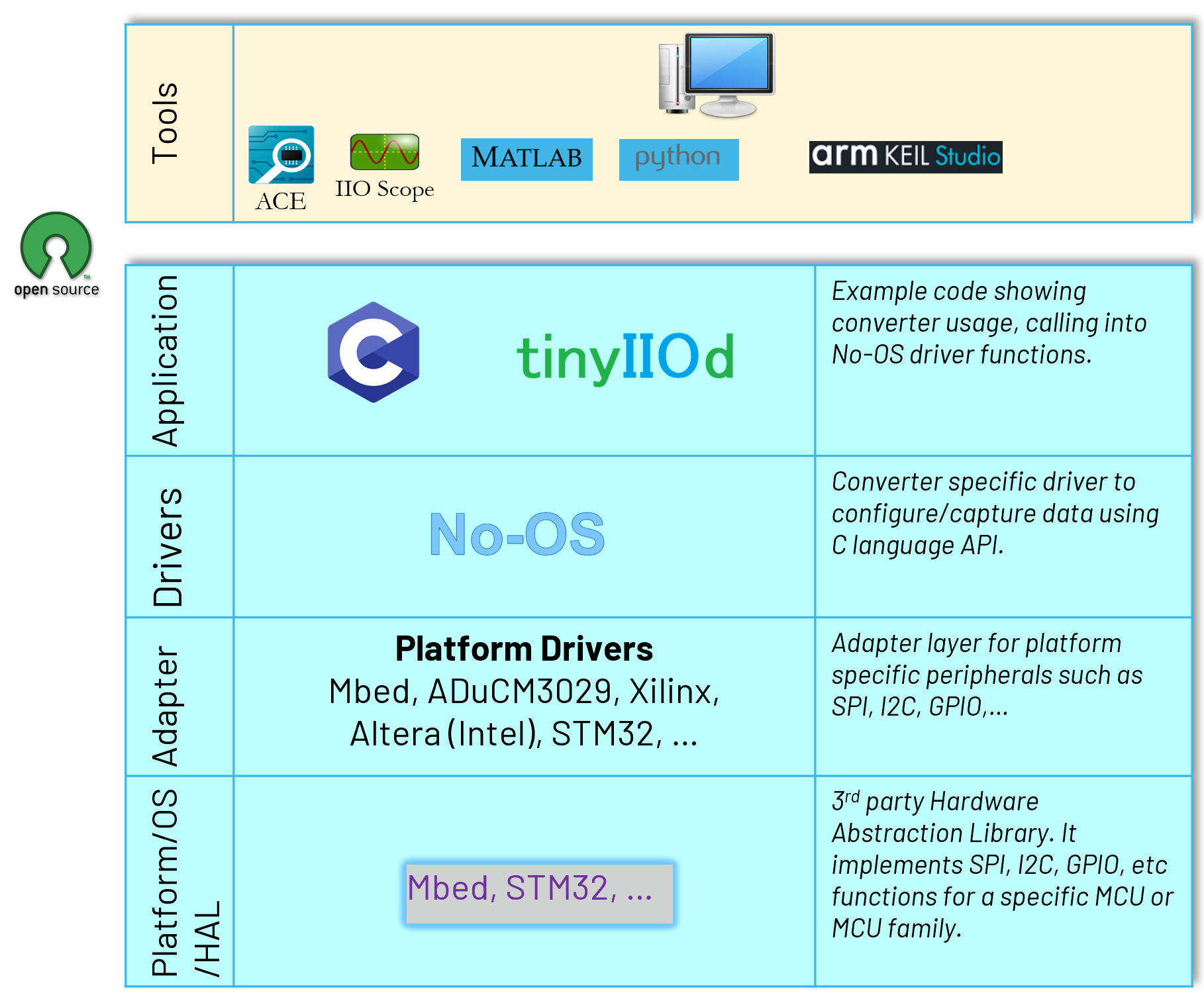
Support
Feel free to ask questions in the EngineerZone
